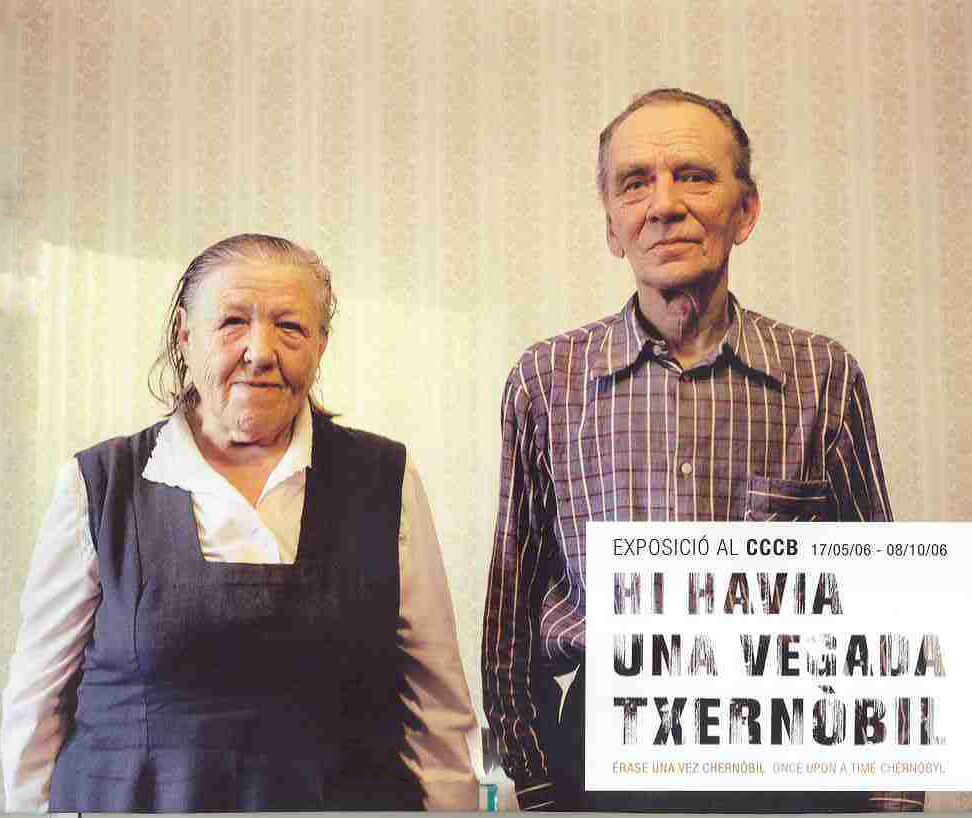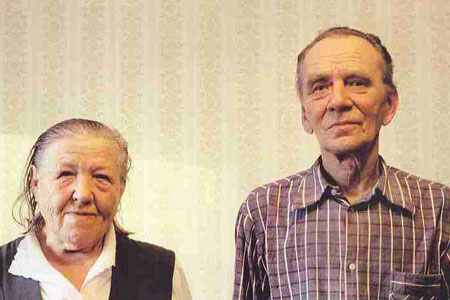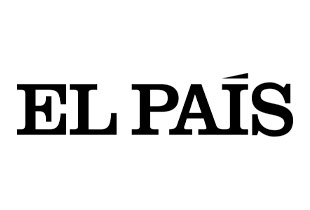Exhibition
Once upon a time Chernobyl
The greatest industrial catastrophe of the history of humankind, the Chernobyl disaster, has never been the subject of an exhibition. Exhibitions have been organized of the work of a specific photographer or of children's drawings, mostly in association with NGO fundraising, but no attempt has been made to show this huge event of contemporary history.
Faithful to its commitment to the events that shape modern times, the Centre de Cultura Contemporània de Barcelona came up with the idea of creating this world first on the occasion of the 20th anniversary of the disaster.
The exhibition tries to answer the following questions:
· Why did Soviet leaders decide to promote nuclear energy when the USSR had vast reserves of petrol and natural gas?
· What exactly happened at the power station on the fateful night of 26 April 1986?
· What action was taken to manage the "liquidation of the consequences of the Chernobyl accident" (official term)?
· What happened during the "battle of Chernobyl", in which approximately one million persons took part? And what happened to the heroes who saved Europe?
· How did the reality of Chernobyl become a fearsome test for the policy of glasnost (opening up) launched by Mikhail Gorbachov?
· Why was it necessary to evacuate some 600 towns and villages, and permanently relocate 350,000 persons?
· What happened to the animals and plants in the evacuated areas, since abandoned by humankind?
· How do people live in the territories of "Chernobyl Land", with its lasting contamination of a total surface area of 160,000 km²?
· What are the health problems and the long-term prospects for the mostly rural populations of Ukraine, Belarus and Russia?
· How is a team of researchers devoted to "extreme ethnography" salvaging a "Ukrainian Atlantis", the culture of the former region of Polesia, which extends between Ukraine and Belarus?
The challenge facing this exhibition is to answer these questions. Its creation has taken years of patient on-site work, mainly in Ukraine, but also in Belarus and Russia. The exhibition curator, Galia Ackerman, a French historian and journalist of Russian origin, went there to find photographs bearing witness to the catastrophe, archive footage from state television channels, objects such as the medals, suits and honorary diplomas of liquidators, press cuttings and publications of the time, maps, children's drawings and many other testimonies of recent history that have not yet been collected in museums.
A philosophical issue
As well as relating a story, however, the CCCB presents the spectator with real problems of the contemporary world. Because Chernobyl changed forever our perception of time, which will never again be linear. Time is now measured in seconds-a few seconds was all it took for the reactor to get out of control, and for a liquidator to "swallow" a border-line or even fatal dose of radioactivity. Time has since moved onto a geological scale that is measured in millennia, because some radioactive isotopes have a very long life, such as the plutonium-239 that contaminated the new town of Pripyat, where power station staff lived. Its period of activity (half-life) is 24,110 years, which means that, in 24 millennia, Pripyat will have half the present-day quality of this highly toxic element that does not exist in nature (it is the product of enriching uranium).
Our perception of space and distance has also been affected. It took just a few days for the famous "Chernobyl cloud" to make its way round the planet, touching almost a billion human beings, many of whom live in countries where there are no nuclear power stations. We will never know for certain how many of these people will suffer from cancer or other pathologies related to the passing of this cloud. Simply, as the great Ukrainian expert Dimitri Grodzinski put it, they took part unknowingly in a "negative lottery". The geographical extension of directly contaminated areas is also shocking. The Sarcophagus is surrounded by cursed areas with vague, shifting borders, like quicksand: "Chernobyl Land" is a large country (a third of the size of Spain) inhabited by some nine million persons, including two million children.
Artistic works
These questions of a philosophical nature are backed by the impact of works of art. Great Western photographers such as Guillaume Herbaut, Robert Polidori and Alain-Gilles Bastide take a close look at the sordid universe of a post-industrial world, the world of Chernobyl. Prestigious artists such as the Ukrainian primitive painter Maria Primachenko and the contemporary Russian painters Edward Stejnberg, Igor Makarevich and Maxim Kantor, and "an enthusiast of the sarcophagus", the young French painter and philosopher Christophe Bisson, all sensitize the spectator to a complex reality of before and after Chernobyl.
Historical, educational and philosophical, this exhibition is a contribution to the future museum of the accident, a project for which has been conceived by the French thinker Paul Virilio. It is an invitation to reflect on our human condition at a time when calamities pervade our daily lives.
Curators: Galia Ackerman
Participants: Victor Kossakovsky
Chernobyl, 20 Years On
Twenty years after the disaster, Chernobyl has become a myth, a symbol, a key word. However, unlike other major natural or technogenic catastrophes, this is an ongoing disaster, and we still do not know the true scope of the damage, particularly with regard to the health of the nine million people who live in this area, which remains contaminated and includes the territories of Belarus, the Ukraine and Russia.
· What really happened on the fateful night of 26 April 1986?
· How did the "battle of Chernobyl" unfold against the invisible enemy, the atom?
· Who were the "liquidators", the million men and women who waged an attack on radioactivity?
· How did the government handle this major crisis that undermined the Soviet Union?
· How does the civilian population live in the contaminated areas?
· What is happening to the animals and plants in this post-industrial world abandoned by man?
Welcome to the world of Chernobyl!
The quest for power
"Communism is Soviet power plus the electrification of the whole country", declared Lenin in 1920. Over and above the real needs of the industry, it was a question of bringing light to the people as a token gesture. Within a few decades, as a result of the construction of power stations and hydroelectric plants, the USSR attained its position as the world's second largest energy producer after the United States. The construction of nuclear power plants from 1954 onwards must be interpreted in this context of becoming an energy superpower or as proof of being a superpower, pure and simple. They were the result of the military-industrial complex and were neither cost-effective nor essential on a practical level: the USSR had enough natural ydrocarbon resources, not to mention an exceptional river network, to guarantee its energy needs for at least a century.
Nuclear reactor
A nuclear reactor is a structure in which a self-sustaining and controlled chain reaction involving the nuclear fission of certain heavy elements can occur under the action of neutrons. The chain reaction takes place in the reactor core or active zone that contains the nuclear fuel and generates heat as fission takes place . Enriched uranium (nuclear fuel) is housed inside stainless steel or zirconium tubes. The active zone also contains a moderator or element that reduces the kinetic energy of the neutrons. A heat-carrying medium circulates through the core in order to cool down the reactor and transfer the heat from it.
The RBMK-type reactor (high-powered channel reactor) was invented in the USSR. It is a graphite-moderated reactor that works with heat neutrons and uses ordinary water as a coolant. This type of nuclear reactor, which was being used at the Chernobyl power plant, is still operational at power plants in Leningrad, Kursk and Smolensk regions, in Russia, and in Ignalina, in Lithuania. The RBMK reactor is characterised by the simplicity of its structure but can become unstable under certain conditions.
The accident
On the night of 25-26 April 1986, the staff of the Chernobyl power station was preparing to stop the reactor for maintenance work . However, before shutting down the reactor, they performed a productivity experiment . This went as planned, then, at 1:23:04 hours, the reactor suddenly accelerated. There was an enormous power surge . Thirty-four seconds later, chief operator Akimov tried to shut down the reactor . The reactor span out of control. Two huge explosions shook the reactor and the engine room. What had happened? Personnel errors? A miscalculated experiment? An unstable RBMK reactor? The disaster was a unique, unrepeatable event, and this is why we will never know for sure the reasons for the greatest industrial catastrophe of the modern world.
The liquidators
"To liquidate the consequences of the nuclear accident": these were the instructions of the Soviet leadership. In order to do this, from the very outset, army units and specialists from 30 ministries were mobilised for the job. The people taking part in the many different clean-up operations were known as liquidators. In the first seven crucial months, from May to November 1986, more than 500,000 civilians and at least 200,000 servicemen and reservists were involved. Their average age was 33. The younger members of the population, who had not had children, were spared. Pilots, drivers, miners, construction workers, electricians, chemists, doctors and engineers worked in high radiation levels, risking their lives in order to save Europe from the worst consequences and build a hideaway for the nuclear beast: the sarcophagus.
The sarcophagus
The sarcophagus was built from the perimeter to the centre; the surviving walls of the exploded reactor were used as foundations for the future monolith that was to be the same height as a 20-storey building. Once the framework was ready, walls were placed around it (some of them 18 metres thick) and a metal frame weighing 165 tonnes was placed over it, inside which were inserted rows of girders measuring 28 and 34 metres in length, which were to support the roof . This high-precision job was carried out from a distance with the assistance of German cranes. One of the most important and dangerous operations involved cleaning the roofs of block 3. Tonnes of fuel and graphite scattered by the exploded reactor had fallen onto them. In total, the construction of the sarcophagus required 300,000 m 3 of concrete and 6,000 tonnes of metal components.
Evacuation
Evacuation due to hazardous radiation levels began the day after the accident. The town of Pripyat was the first to be evacuated, and then 187 other towns and villages in the three Soviet republics concerned (Ukraine, Belarus and Russia) were evacuated in spring and summer 1986 (116,000 people in all). The evacuation continued over the following years: 135,000 people were rehoused between 1987 and 1990, and almost 100,000 between 1991 and 1992. Nearly 600 villages became uninhabitable and some were razed to the ground and buried. Others were just abandoned and became overgrown with plants and brambles. The following areas were defined: an exclusion zone (covering some 2,500 km² around the power plant), compulsory evacuation zones (with ground concentration levels of caesium-137 in excess of 15 Ci/km²), voluntary relocation zones (between 5 and 15 Ci/km²) and zones under radiological surveillance (1 to 5 Ci/km²).
Pripyat - ghost town
On 27 April 1986, the tannoy system in Pripyat announced that due to an "unfavourable radiological situation" evacuation was necessary. As it was only supposed to last for two or three days, the inhabitants were advised to take with them nothing more than a picnic basket, toiletries and a change of clothes, and to leave their pets outside. At the time, no one suspected that this departure would be permanent. The scientists believed that the radioactivity would decrease once the reactor had been buried with sand. All the animals were shot by teams of expert shooters, and the same thing occurred later in other evacuated towns and villages.
The town of Pripyat will never be inhabited again: it is contaminated, among other things, with plutonium-239, which has a half-life of 24,110 years. In 24,000 years' time, there will still be half the current amount of plutonium-239 in this town, which will be cursed for evermore.
The wreckage of Chernobyl
Thousands of helicopters, armoured vehicles, lorries and all kinds of motor vehicles were present on the vast building site of the "battle of Chernobyl". They were washed every day with decontaminating liquid but soon became sources of ionizing radiation themselves. The exclusion zone around the power plant has 800 radioactive-waste storage sites, including a spectacular open-air graveyard of contaminated vehicles. A redoubtable weapon of the Cold War, the early warning radar to detect intercontinental missile launches located near the power plant has now been reduced to a piece of scrap: its electronic system was affected by radiation and stopped working on the day of the accident.
A natural radio-ecological reserve
This is the name given to the exclusion zone by the Belarusian authorities. The desertion of entire regions by man has completely changed the gift of nature. The fertile ground has become boggy, there are frequent fires that release radionuclides into the air every time they occur. Certain species have disappeared while others such as wolves, foxes, wild boar and elk have bred profusely and even the wild Przhevalski horses, imported from the Crimea, have adapted well. Because of the viral mutations caused by radiation, the area is a source of new, highly aggressive and resistant viruses. Nevertheless, there are several hundreds elderly people who refuse to leave and still live there, having returned to a state of autarky. Some of them would rather die than leave the land of their forebears.
What is happening to the human population?
We will never know the whole truth about the number of dead, invalids and sick people in the wake of Chernobyl. This is because the Soviet authorities immediately falsified medical data about the health of the liquidators and the civilian population in the contaminated territories, and the registers of liquidators, which are incomplete, were not compiled until 1991. In a communiqué from April 2005, the Ukrainian authorities stated that 94.2% of the "liquidators", 89.9% of the people evacuated from the contaminated territories and 84.7% of the people still living in the territories affected by radiation are ill today. Independent researchers list at least 20,000 dead and over 200,000 invalids among the liquidators.
Two non-conformist scientists
In 1986, the Belarusian academician Vassili Nesterenko was the director of a state-of-the-art military project. The Chernobyl disaster turned the life of this renowned nuclear physicist upside down: he resigned from his official duties to devote himself to the protection of the civilian population, particularly children from the contaminated zones. He was the first person to give his support to Yuri Bandazhevski, director of the Gomel Institute of Medicine (Belarus), who discovered a link between the absorption by humans of low doses of caesium-137 through the food chain and health problems among the people living in the contaminated zones. This discovery upset the Belarusian authorities and Bandazhevski was put on trial on a trumped-up charge and spent over four years in prison and at a labour camp. He was recognised as a prisoner of conscience by Amnesty International and released in August 2005, but he no longer has the right to work in his field. In May 2006, Bandazhevsky was allowed to leave his country and found refuge in Clermont-Ferrand, France, where he will continue his research.
A second accident, only just avoided
Another extremely violent explosion occurred five years later, on the night of 11-12 October 1991, in block 2 of the Chernobyl power plant. According to the eminent Russian physicist, Leonid Urutskoyev, it was caused by a short circuit in the turbine room. However, this time, he reported, the staff was better prepared and reacted very quickly: the second reactor was shut down before an explosion could take place inside its core. It was never restarted and, faced with what seemed like a dark threat, a top-level decision was taken to gradually close down the Chernobyl plant.
Antinuclear reaction
In a society that for generations had forgotten the meaning of freedom of speech, association, worship and the right to strike, the tragedy at Chernobyl was a jolt to the popular imagination and led to large-scale environmental movements with increasingly violent protests. Resentment was particularly strong in the Ukraine and made a vital contribution to the formation of a national protest group, one of the driving forces that led to the disintegration of the USSR. However, after the collapse of the Soviet empire, the former liquidators were scattered all over a vast country that had been transformed, in the blink of an eye, into a mosaic of independent states, where they had to fight for their past to be recognised.
What is happening to the plants and animals?
After the disaster, phenomena of morphogenesis such as gigantism and dwarfism were initially observed in irradiated plants and animals. Later, it was noticed that low radiation doses absorbed through the food chain could lead to genetic instability and damage heredity molecules. There was a significant increase in miscarriages and the number of animals born with severe malformations. Of the carp that fed in the silt of ponds contaminated with caesium-137, only 30% of their eggs hatched and developed properly, and 70% of their hatchlings showed macroscopic malformations: smaller scales, deformed fins, and lack of eyes and mouths.
The power plant today
Contrary to popular belief, the power plant is still teeming with people. The reactors have been shut down but they require maintenance. A company is responsible for decontaminating metal debris and another takes the necessary measures to protect the water table; scientists continue to study the behaviour of the exploded reactor beneath the sarcophagus and perform numerous experiments in the area; foresters monitor areas of woodland to prevent fires; fire-fighters are in a constant state of alert, and security agents guard the area around the exclusion zone. The old town of Chernobyl is the dormitory for the nuclear shift workers who sleep here during the week and rejoin their families at the weekend.
The Ukrainian Atlantis
This is the name given to the evacuated Ukrainian territories by the devotees of Polesia, one of the oldest Slavonic regions. With the rehousing of a rural population that retained its old way of life came the loss of its customs, traditional implements and objects of worship and everyday life. In order to save them, a team of ethnographers has been braving the hazards of radioactivity and scouring hundreds of abandoned villages since 1992. To date, some 10,000 objects that have been collected in this way are piled up in three warehouses (one of them is Chernobyl's former cinema) but soon these relics of a vanished past will be put on display in a museum. This project is spearheaded by the Ukraine Ministry for Emergency Situations.
The secret protocols of the Politburo
The Politburo of the Soviet Union Communist Party Central Committee was the most powerful political body in the USSR. On 29 April 1986, the Secretary General of the SUCP, Mikhail Gorbachov, ordered the setting up of an operational group within the Politburo to supervise all matters regarding the Chernobyl disaster. The group met regularly to handle the crisis until 1988. The protocols of these meetings were kept secret. In 1991, the Ukrainian journalist Alla Yaroshinskaya obtained a copy. These protocols show that the Soviet authorities were mainly concerned about reopening the damaged plant and much less concerned about the health of the people in question.





